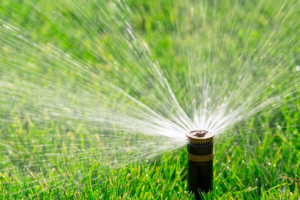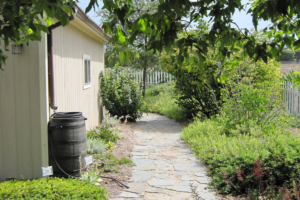Yard Drainage: Everything You Need to Know
February 25, 2022

Yards are important spaces for families: the kids play ball, dogs run around, and parents sunbathe with some tunes playing. But they can also be a major source of stormwater pollution if water isn’t draining properly. Since everything that flows into the storm drain system goes untreated into Orange County’s creeks, rivers, and ocean, any water that flows from your yard into the street and storm drains (either from rain, washing, or sprinklers) can bring dirt, debris, pet waste, fertilizer, or pesticides with it.
Poor yard drainage can also lead to major structural issues with your home. Whatever the cause, there are many easy ways to fix drainage issues that will keep your yard thriving while protecting our waterways. Continue reading below to learn more!
Why Runoff is an Issue
Polluted runoff from your property is a problem because of its effects on human and ecosystem health. Whether it’s runoff from rainwater or a leaking sprinkler, these flows can transport bacteria, trash, metals, and other pollutants untreated into our waterways via the storm drain system. When these pollutants runoff from your property, they can harm aquatic life, decrease water quality, and cause beach closures. Protecting our water resources from runoff pollution is a community effort that requires everyone to do their part. Below are some tell-tale signs of yard drainage issues and ways to address them so that you can join in on being the solution to runoff pollution!
Signs of Yard Drainage Issues
If you see any of these occurring in your yard, you likely have a drainage issue:
- Standing pools of water.
- Continuous drainage or plant growth at the curb outlet of a French drain system (often called a weep hole).
 Weep hole with drainage and plant growth.
Weep hole with drainage and plant growth.
- Mildew, algae, or plant growth on pavement or the side of your home.
- Soil erosion.
Strategies to Address and Prevent Drainage Issues
If you see any signs of yard drainage issues, you want to evaluate when, where, and how the issue is occurring. This will help indicate the source of the problem, and how to best address it.
Here’s how you can tackle your drainage issues head-on:
1. Prevent Overwatering
If it is not raining, no water should be draining from your property. The most common reason water runs off in the dry season is from overwatering, which can cause mold, moss, erosion, and carry pollutants in runoff.
If you notice runoff or pools of water in your yard unrelated to a recent rain, here are the things you can do:
- Conduct an irrigation tune up. Grab a timer and run each zone of your irrigation system. For each zone, note the time water starts to run off your property and adjust your schedule so that no zones are watering for too long. By adjusting the watering time, you quench your yard’s thirst without giving it more than it can handle. Find watering guidelines and customizable calculators on how much water your yard needs by going to bewaterwise.com and Municipal Water District of Orange County.
- Repair irrigation system leaks immediately. During your tune up, be on the lookout for leaks and repair them as soon as possible. Also keep an eye out for continuously draining weep holes, as they can be a sign of an undetected water leak. The longer your sprinkler is leaking, the more water will be wasted, pollution will get into our waterways, and damage can be done to your property.
 Sprinkler in a yard.
Sprinkler in a yard.
- Turn your irrigation system off during or right before a rainstorm. Performing a ‘rain skip’ can help reduce runoff from your property. When storms roll through, the rain has taken over watering duties so you don’t need to! There are also may be rebate programs available through your local water district or SoCal Water Smart to help cover the costs of upgrading your irrigation system to a weather based controller.
- Use a moisture meter. Moisture meters feature easy-to-read dials to indicate if the soil is dry, moist, or wet. You can find moisture meters and soil moisture sensors at home improvement stores and irrigation supply stores. Rebates may also be available.
2. Allow for Proper Drainage
Standing water does can affect your property; however, there are also environmental and human health impacts that homeowners must consider when faced with drainage issues. Proper drainage is critical to keeping your home’s foundation intact, minimizing the mobilization of pollutants, and reducing the prevalence of disease-carrying mosquitos.
Here are ways to improve your yard’s drainage infrastructure:
- Utilize weep holes properly. Weep holes are helpful during a rainstorm since they drain water from your property. However, they should remain dry when it is not raining. If water from irrigation regularly flows from weep holes, plants and algae can begin to grow inside them and cause blockages or clogs. To prevent this, direct sprinkler heads away from any area drains. You can also temporarily cover the drain inlets while watering or doing yard work.
- Install gravel, a dry creek bed, or a rain garden in problem areas. These yard features are terrific tools for absorbing excess water and look great too! They are structured to allow water to soak into the ground instead of ponding or running off. Learn more about creating a rain garden here.
 Dry creek bed.
Dry creek bed.
- Ensure your yard drains away from your home. Your yard should slope away from your house and to an area with good infiltration, ideally a rain garden or dry creek bed. If your yard isn’t sloped enough, excess water will pool instead of draining properly. Install additional drainage and ensure that your yard is properly sloped between 2%-5% away from your home.
- Adjust your downspout. By redirecting your downspout to a rain garden, dry creek bed, rain barrel, or an underwatered part of your yard, you can prevent pooling and reduce runoff.
 Downspout in a yard redirected to a rain barrel.
Downspout in a yard redirected to a rain barrel.
3. Conduct Yard Maintenance
Proper yard maintenance can help prevent drainage issues and reduce runoff. Here are easy ways to maximize your yard’s drainage capabilities while protecting our waterways:
- Regularly clean your home gutters. If your home gutters are clogged, water can spill out to the side of your home and cause mold, mildew, and algae to grow on the side of your home. It can also harm your home’s foundation and cause other structural problems. Fungal and vegetation growth can harm your family, your property, and our waterways.
- Pickup and properly dispose of yard debris. Leaves and lawn clippings can clog drains and lead to flooding. Regularly clean up your yard and dispose of yard debris in covered bins.
More Ways to Protect Our Waterways
Some other ways you can protect Orange County’s creeks, rivers, and ocean while helping your yard thrive are:
- Aerating your soil to reduce soil compaction and help your plants get the nutrients they need, as well as absorb more water.
- Picking up after your dog before it rains can prevent bacteria from flowing into the storm drain.
- Keeping waste bins and compost piles covered to prevent any waste from flowing untreated into the storm drains on a windy or rainy day.
Go to our Landscape Improvement and Capture Water pages for more ways to prevent overwatering and runoff.
We all want what’s best for our community, so make sure to share these tips with your friends, coworkers, and neighbors. By ensuring your yard drains properly, you’re helping keep OC’s creeks, rivers, and ocean healthy. Thank you for doing your part to help your yard flourish while protecting Orange County’s waterways!
i am looking for an attachment that would hook up to my downspout and would have a “flap” that would allow me to drain into a barrel or street drain
H2OC Stormwater Program Post author
Hi Lawrence, thanks for your comment. You can go to your local home improvement store to find a rain barrel attachment with a flap to help water drain smoothly into your rain barrel. Since anything that flows into the storm drain goes untreated into our waterways, do not direct runoff into the storm drain. Instead, direct it to a landscaped area. Let us know if you have any other questions! Have a wonderful day.